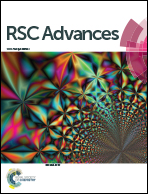Phospholipid electrospun nanofibers: effect of solvents and co-axial processing on morphology and fiber diameter
Abstract
Asolectin phospholipid nano-microfibers were prepared using electrospinning processing. The asolectin fibers were studied by scanning electron microscopy, and the fiber morphology was found to be strongly dependent on the phospholipid concentration and the solvents used. The solvents studied were chloroform : dimethylformamide (CHCl3 : DMF, 3 : 2 v/v), isooctane, cyclohexane and limonene, producing phospholipid fibers with average diameters in the range of 2.57 ± 0.59 μm, ∼3–8 μm, ∼4–5 μm and 14.3 ± 2.7 μm, respectively. The diameter of asolectin electrospun fibers does not follow the theoretically predicted value of ∼0.35 μm because of the intermolecular aggregation between the reverse micelles formed in the highly concentrated asolectin solutions. However, when co-axial solvent electrospinning was applied, where the outer needle contains a pure solvent and the inner needle contains the asolectin solution in CHCl3:DMF, a substantial reduction in the average fiber diameter was observed. In particular, the average diameter of the fibers when DMF (a solvent with a high dielectric constant) was used as a sheath solvent was reduced by a factor of about 7 and was at the nano-size range, as theoretically predicted. The dielectric constant of the solvents had a strong influence on the jet split properties and affected the morphology of the electrospun asolectin fibers.


 Please wait while we load your content...
Please wait while we load your content...